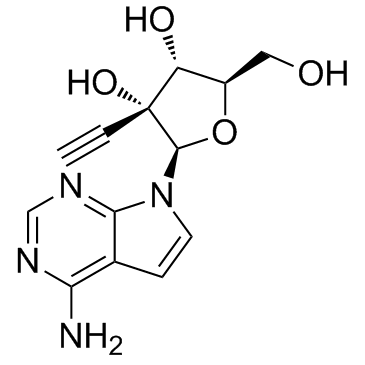| Description |
NITD008 is a potent and selective flaviviruse inhibitor which can inhibit Dengue Virus Type 2 (DENV-2) with an EC50 of 0.64 μM.
|
| Related Catalog |
|
| Target |
EC50: 0.64 μM (DENV-2)[1]
|
| In Vitro |
NITD008 potently inhibits other, including Dengue virus (DENV), West Nile virus, yellow fever virus, and Poissan virus. NITD008 inhibits DENV-2 in a dose-responsive manner, with an EC50 value of 0.64 μM; treatment with 9 μM compound reduces viral titer by >104-fold[1]. NITD008 also inhibits a luciferase-reporting replicon of hepatitis C virus (HCV, genotype 1b), a member from the genus Hepacivirus, with an EC50 value of 0.11 μM[1].
|
| In Vivo |
NITD008 is orally bioavailable and has good pharmacokinetic properties. NITD008 exhibits the best pharmacokinetic parameters when formulated using 6 N of HCl (1.5 equimolar amount), 1 N of NaOH (pH adjusted to 3.5), and 100 mM citrate buffer (pH 3.5). Following i.v. injection, NITD008 has a high volume of distribution (3.71 L/kg) and a low systemic clearance (31.11 mL/min per kg), resulting in a long elimination half-life (t1/2=4.99 h). After p.o. dosing, NITD008 is rapidly absorbed (time of peak plasma concentration=0.5 h), with a maximal plasma concentration of 3 μM and bioavailability of 48%. Treatment of the mice immediately after viral infection with 1 mg/kg of NITD008 does not reduce mortality, but treatment with 3 mg/kg partially protects and treatment with ≥10 mg/kg completely protects the infected mice from death. NITD008 can suppress peak viremia, decrease cytokine elevation, and prevent death[1].
|
| Cell Assay |
For measurement of compound cytotoxicity, Vero cells (10000 cells per well of a 96-well plate) are incubated with various concentrations of NITD008 (3, 6, 12, 25, 50 μM) for 48 h; cell viability is quantified using a MTT assay[1].
|
| Animal Admin |
Mice[1] The in vivo efficacy of NITD008 is evaluated in a dengue viremia model and a lethal model in mice. Both models use AG129 mice (with knockout IFN-α/β and IFN-γ receptors). DENV-2 strains TSV01and D2S10, respectively, are used in the 2 models and are propagated in C6/36 mosquito cells grown in RPMI-1640 medium with 5% FBS (vol/vol) at 28°C. The evaluation in the lethal model is performed by injecting mice i.v. with 0.2 mL of RPMI-1640 medium containing 3×107 pfu/mL DENV-2 strain D2S10; the infected mice are then subjected to different treatment regimens, as indicated in each experiment. NITD008 (1, 3, 10, 25, 50 mg/kg) in 0.2-0.25 mL of formulation solution is administered by p.o. gavage. The mice (6 or 8 mice per group) are monitored twice a day[1].
|
| References |
[1]. Yin Z, et al. An adenosine nucleoside inhibitor of dengue virus. Proc Natl Acad Sci U S A. 2009 Dec 1;106(48):20435-9.
|
